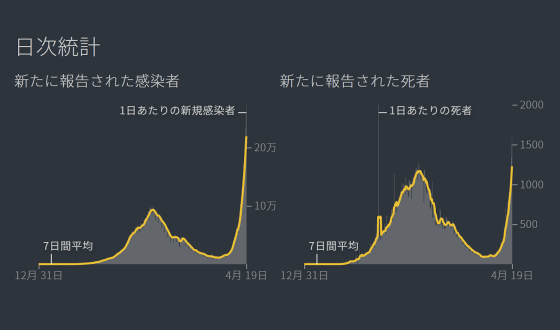Why is the infection exploding in India, which should have 'successfully contained the new corona'?

In India, the number of newly infected people with the new coronavirus infection (COVID-19) peaked around September 2020 and began to decline, and it was said that 'India succeeded in suppressing COVID-19.' However, the number of newly infected people increased sharply from around March 2021, and on April 19, the number of newly infected people per day
After early success, India's daily COVID infections have surpassed the US and Brazil. Why?
https://theconversation.com/after-early-success-indias-daily-covid-infections-have-surpassed-the-us-and-brazil-why-158783
In India, the number of new COVID-19 infections exceeded 10,000 per day for the first time in June 2020, and peaked at over 90,000 per day in September of the same year. However, after that, the number of newly infected people began to decrease, and in late January 2021, it was reported that 'newly infected people were not reported in 20% of the whole of India for one week in a row', and Harsh of India. 'India has succeeded in containing the infection,' Vardhan said.
India Declares New Corona Suppression No New Infection in 20% of Areas for 1 Week | Reuters
https://jp.reuters.com/article/health-coronavirus-india-idJPKBN29X1DW
However, from around March 2021, the number of newly infected people per day began to increase rapidly, and India was hit by the second wave, which is larger than the first wave. Below is a graph showing the number of new infections and deaths in India published by Reuters. After peaking around September 2020, both the number of infected people and the number of deaths have decreased, and the number of newly infected people has fallen below 20,000 from January to February 2021. It seemed that the infection had subsided for a while, but the number of infected people increased sharply from around mid-March, and the number of newly infected people per day exceeded 100,000 in early April. At the time of writing the article, more than 200,000 newly infected people have been confirmed every day.

In response to this situation, in Maharashtra, which has Mumbai, one of India's largest cities, as its capital, infection prevention measures such as curfew and blockade of cities on weekends have been revived. In addition, the Delhi metropolitan area government, centered on India's capital, Delhi, also
According to Dasgupta, India's medical services and crematoriums are already under pressure, and the COVID-19 test kit is in short supply. The effects of the pandemic are particularly strong in slum dwellers and those who do not have toilets at home, and poor hygiene and high population density contribute to the spread of the infection, Dasgupta points out.
Some may simply think of India as a 'fault' as to why India, once infected, is once again in crisis. Lack of regulation in the workplace and public spaces is also a problem, as well as individuals who neglect to wear masks and maintain social distance. After the declaration of containment, religious festivals, sporting events, elections, etc. were held without infection control measures in India.
In addition, the mutant strain 'B.1.1.7 ' that caused the spread of infection in the United Kingdom is also said to be affecting the infection explosion in India. A March 2021 survey found that 81% of the 401 samples collected in Punjab were 'B.1.1.7'. 'B.1.1.7' is said to be highly infectious among the new coronavirus mutants, and people who have experienced COVID-19 in the past may be re-infected.
In addition, a new type of coronavirus mutant that occurred in India is also considered to be a factor in the spread of infection. It is reported that the mutant strain 'B.1.617', which is prevalent in some parts of India, has already reached the United Kingdom.
What do we know about the Indian coronavirus variant? | Coronavirus | The Guardian
https://www.theguardian.com/world/2021/apr/19/what-do-we-know-about-the-indian-coronavirus-variant

India was praised in the early stages of the pandemic as 'COVID-19 mortality rate is about 1.5%, lower than the world average', but it has been pointed out that this may be 'false optimism'. I did. In India, many state health officials have been criticized for 'not accurately counting the number of deaths associated with COVID-19,' and an expert committee member to review and verify the number of deaths from COVID-19. Established a meeting. Result of the re-investigation, and mortality in several states have more than about 3.4% of the world average, in some areas more than about 5% have been reported .
To date, the majority of cases and deaths in India have been reported in large cities, including Punjab and Maharashtra, but infections are shifting from large cities to suburbs and small towns with poor health infrastructure. That thing. Dasgupta pointed out that in 2020, non-health staff members who had been mobilized for COVID-19 measures will be returned to their original departments, which could affect case tracking, testing and treatment. He also claims that healthcare professionals are burdened with vaccination in addition to treating patients. In India, the target is 150 million vaccinations per month, but at the time of writing the article, it seems that it is only about 70 to 80 million times per month.
Dasgupta pointed out the need to strengthen regional containment measures until widespread vaccination is achieved, and strong regional-focused leadership is important. Needless to say, large meetings such as political rallies and religious festivals should not be held.

Related Posts:
in Note, Posted by log1h_ik







